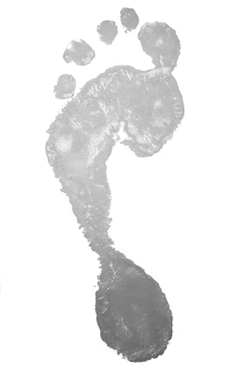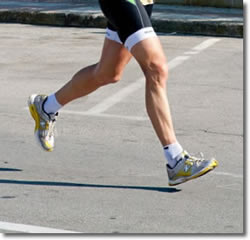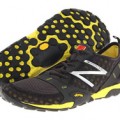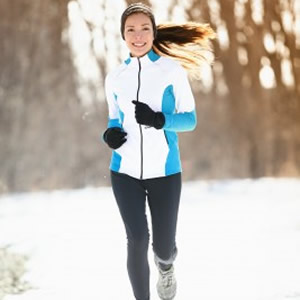You may be surprised to learn that the traditional assumptions that have guided the design and prescription of running shoes over the past three decades lack scientific support. This article provides a research-based perspective on the topic, and equips you with a set of guidelines for choosing shoes for optimal health and performance.
Part of the beauty of running is its simplicity. The only piece of equipment that most runners require is a good pair of running shoes. Strap shoes on your feet and you’re good to go!
But what constitutes a good pair of running shoes? More importantly, what running shoes are best for you given your particular needs? In light of recent attention given to barefoot running and minimalist shoe designs, what exactly do shoes do for you anyway? And what should you look for as a runner interested in comfort, performance, and injury prevention?
My aim in writing this article is to provide a guide to running shoes based on the latest evidence found in peer-reviewed academic journals and utilized by up-to-date biomechanists, physical therapists, and running coaches. Along the way, I outline the traditional (outdated) view on running shoe design and prescription—a perspective that is still alive and well when you walk into many running shoe stores today—and argue for a new, simple set of guidelines that you can use to ensure the running shoes you purchase meet your needs as a runner. After all, why spend hundreds of dollars on running shoes unless they support your needs?
The Traditional View on Choosing Running Shoes

Let’s start by taking a look at the traditional view on choosing running shoes, which starts with arch type. From a clinical perspective, this view is easy to implement because it provides three neat categories for classifying foot types: high arch, medium arch, low arch. Determining which category you fit into is as easy as having someone look at your arches while standing (or standing on pavement with wet feet and examining the footprint). These foot types are then associated with the amount of pronation assumed to occur upon foot strike.
Pronation refers to the inward movement of your foot upon landing. Pronation is what allows your body to absorb the shock of your footfall. Pronation is necessary for adequate shock absorption; but excess pronation—called “overpronation”—has been thought to lead to common running injuries (e.g. plantar fasciitis, shin splints, knee problems). The traditional view assumes that flatter feet overpronate and that this excess motion needs to be controlled through shoe features. This leads to the three types of shoes you find when you go into the running shoe store:
Neutral, or cushioned shoes. Neutral, or cushioned shoes have a uniform color and uniform density throughout the midsole, and are built on a curved last. These types of shoes are prescribed for neutral runners and underpronators (and also for the rare supinator) with normal to high arches.
Stability shoes. You can spot a stability shoe by picking it up and looking at the medial (inner) side. You will often see a darker color (gray) or some sort of plug, often called a medial post. This darker material is denser than the surrounding (white) material. The principle behind stability shoes is that the denser material is supposed to slow down the pronation (i.e. inward movement) of the foot when landing on the heel. Stability shoes are usually built on a semi-curved last to accommodate some arch.
Motion control shoes. Motion control shoes are more extreme than stability shoes. As with stability shoes, you’ll find the darker (denser) material and/or plug on the medial side in an attempt to control pronation. In addition, the shoes are built on a straight last to accommodate low arches or flat feet. They are almost like buying shoes with built-in orthotics.
Another common design feature of traditional running shoes is an elevated heel. Typically, a two to one ratio is common with the heel being twice as high as the toe. The heel is where all that cushy material is placed for shock absorption in an effort to ostensibly attenuate impact forces.
Richards, Magin, and Callister (2009) dub shoes with these traditional design elements “Pronation control, Elevated Cushioned Heel” (PECH) running shoes. They conducted a comprehensive review of the scholarly literature for studies that would support the prescription of PECH shoes based on foot type. What they found should surprise many who advocate the traditional view: there is no research evidence to support the prescription of PECH shoes for injury prevention.
Their review does not mean these types of traditional running shoes are necessarily ineffective, but it does mean that there is no scientific evidence to support the traditional model of shoe prescription and design that has become common wisdom in the running shoe industry over the past three plus decades.
Challenging the Traditional Model of Running Shoe Prescription and Design
If we look more closely at the traditional assumptions of running shoe prescription and design, recent studies provide evidence that PECH shoes are not all that the marketing hype makes them out to be. Knapik et al. (2010), for example, demonstrate that prescribing shoe types (cushioned, stability, motion-control) based on arch types (high, medium, low) has little influence on injury prevention.
Part of the ineffectiveness could come from the assumption that the amount of pronation during running neatly correlates with foot type. Remember, the traditional view prescribes shoe type (cushioned, stability, motion-control) based on foot type (high, medium, low arch). The assumptions are that the foot type can act as a window into how much the foot pronates while running, and that this pronation needs to be controlled. However, Dicharry et al. (2009) show that tests done to assess foot structure while standing do not neatly predict what the foot does while running. Again, there is little indication that someone with any one of the three standardized foot types would benefit from the industry’s corresponding shoe types as tools for injury prevention (Barnes et al. 2008, 2011).

With regard to the elevated cushioned heel in traditional shoes, we do know from studies that such features negatively impact proprioception and joint stability (Robbins and Gouw 1990, 1991; Robbins, Waked and McClaran 1995; Robbins et al. 1995; Robbins and Waked 1997; Hennig, Gordon, and Liu1996; Lake and Lafortune 1998; Robbins and Waked 1997; Sekizawa et al. 2001).
Proprioception refers to the ability to sense and feel the position, location, and orientation of the body (and its parts) during movement. When running, a foot’s proprioception guides it into position upon landing to absorb impact forces and provide stability to the joint. In effect, all that cushy material in those elevated heels of traditional running shoes detracts from the ability of the foot to do its job.
Further, the assumption that increased cushioning material in shoes translates into lower impact forces upon landing has been shown to be incorrect (Nigg et al. 1987; Nigg et al. 1988; De Wit et al. 1995; Hennig et al. 1996; Milani et al. 1997; Dixon et al. 2000). To the contrary, the more cushioning in the shoe, the harder the foot tends to land. The mechanoreceptors in the foot—which are sense organs involved in proprioception—have difficulty working effectively when a thick layer of cushioning material lies between the foot and the ground.
In addition, elevating the heel shifts foot loading forward, which leads to a quad-dominant firing pattern with less reliance on the gluteus maximus (Wallden 2010). Shifting the workload to the quads while inhibiting the firing of the glutes results in anterior pelvic tilt and excessive arch in the lower back (Wallden 2010, p. 188; Sahrmann 2002). As I’ve discussed in a previous article that examines the role of the glutes in running, when the pelvis tilts forward and there is excessive lower back arch, an overlengthening of the hamstrings results: “When the glute max clocks out or fails to report for duty, the hamstrings are not only left to carry the burden of hip extension, but they are asked to do this in an overlengthened state as a result of the anterior pelvic tilt. This can be a pain in the butt or hamstring—quite literally.”
Improper muscle firing patterns are an important culprit behind many running overuse injuries. Yet traditional running shoes only contribute to the problem of inactive glutes (a problem also compounded by excessive amounts of sitting) and detract from functional stability. Much of the functional strength training, neuromuscular activation exercises, and drills for runners are aimed at ingraining healthy movement patterns into muscle memory, including (re)training the glutes to fire as needed for an effective (injury free) running stride. Wouldn’t it be nice if your shoes didn’t work against this effort?
In sum, scientific studies to support the traditional PECH running shoe model are conspicuously absent. At the same time, numerous studies show the negative repercussions of elevated heels and excessive cushioning while also emphasizing the ineffectiveness of PECH shoes in preventing common running injuries.
The Foot Strike Debate

At this point, it is perhaps necessary to address the issue of fore-foot/mid-foot versus rear-foot landing. It is necessary because this issue has generated intense debate in the running community. Unfortunately, in my view, the debate (although interesting) acts as a bit of a red herring. It can detract from more central issues in choosing running shoes.
Given the current state of research, I believe it is best to take an agnostic position when it comes to foot strike. There simply isn’t enough evidence to conclusively argue for one pattern over another. Substantial variability exists among both shod and barefoot runners, and there are pros and cons to the different patterns. It is difficult to argue for a one-size-fits-all solution in this area. Whether one first lands on the heel or contacts with the mid-foot or fore-foot before lowering the heel depends upon many variables unique to the individual runner’s needs, situation, and even skill. With that said, let’s look at what we do know with regard to foot strike patterns during running.
The place to start is the research conducted by Daniel Lieberman and colleagues, made famous by the barefoot running movement and Christopher McDougall’s (2011) book, Born to Run. As explicated in Lieberman’s video, the crux of the research shows that “barefoot runners who fore-foot strike generate smaller collision forces than shod rear-foot strikers” (Lieberman et al. 2010, p.531). This finding accords with the research cited above that also shatters the traditional assumption about the role supposedly played by an elevated cushioned heel in traditional running shoes. Instead of providing the shock absorption promised in running shoe advertising, elevated cushioned shoes can actually lead to greater impact forces with their false sense of security (Robbins and Waked 1997).
Hatala et al. (2013) support the finding by Lieberman et al. (2010) regarding the attenuation of impact forces with fore-foot landing; but also show that fore-foot landing is not a universal pattern among habitually barefoot populations. Rather, in the population they studied—the Daasanach of northern Kenya (Lieberman and colleagues studied Kalenjin runners in Kenya)—foot strike patterns varied with running speed. The Daasanach tended to switch to a mid-foot or fore-foot strike at faster speeds, a pattern more common to shod runners. In a panel discussion on barefoot running I attended a few years ago in Boulder, Olympic runner Alan Culpepper spoke to this pattern. He noted that he heel strikes on long, slow distance runs while he adopts a fore-foot strike at faster speeds and shorter distances.
Returning to the points made earlier, whether the runner strikes first with the heel or the fore-foot appears to be less important than the amount of proprioception afforded the runner upon landing. The debate will continue over the pros and cons of different foot strike patterns; but we do know that increased proprioception allows for better diversion of impact forces. As running coach Bobby McGee explains in his video on running mechanics, “The more effectively the leg can load onto the surface, the less shock it needs to absorb, the more elastic energy it can store, and the more powerfully and economically it can return this power to the runner.”
Lessons from Habitually Barefoot Populations
Beyond the foot strike debate, there are additional (and more important) lessons to take from studying barefoot populations. As D’Aout et al. (2009) point out, habitually wearing shoes substantially alters foot shape and function. Namely, unshod populations exhibit wider feet that more uniformly distribute peak pressures across the foot—which means more stability. The photos below are from D’Aout et al. (2009, p. 86) and show two examples of habitually barefoot research participants in India.

When walking or running barefoot, the toes splay out upon landing. Likewise, you also do this with your hands when, for example, you put them on the floor to do a push-up. However, the natural splaying of your toes is inhibited when wearing traditional shoes with a tapered toe box. The narrow toe box binds the toes together in the fore-foot. It’s like a less extreme version of traditional Chinese foot binding (Jackson 1990). Imagine trying to do daily tasks with the fingers of your hands bound together to prevent the individual digits from spreading out. Much dexterity, stability, and function is lost in the process.
Crucially, narrow shoes severely limit movement of the big toe. Why is this important? Because the big toe is responsible for providing nearly all your stability while running. In particular, the muscle known as the flexor hallicus brevis drives the foot down while the abductor hallicus widens the foot for improved leverage. As Dicharry (2012) notes, “If you can improve control to drive the big toe down and actively spread it, you’ll experience true Zen in foot control” (p. 127).
But effectively utilizing these muscles is impossible if your shoes bind your toes together. The photos below are from Dicharry (2012, p. 129) and illustrate the natural splay of the toes when barefoot (on the left) versus the squeezing of toes in shoes with a tapered toe box (on the right). The bunions common among shod populations—which are unknown in barefoot populations—are a result of this form of modern day foot binding.

Setting aside the issue of footwear for a moment, I want to emphasize that all runners will benefit substantially from improving strength and neuromuscular control in the feet, especially the big toe. We target muscles throughout the legs, hip, abdominals and back to improve postural control and core stability. Why do that but neglect the intrinsic muscles of the feet which also contribute to stability? Unfortunately, this is what the traditional running shoe paradigm has encouraged us to do, pretending that PECH shoes can somehow magically replace the work otherwise required of the feet to absorb shock and provide stability.
But everything is connected up and down the body; and the feet need to work in conjunction with the legs and hips to run effectively. So in addition to strengthening your running core (with a focus on the glutes along with the stabilizing muscles of the hips), working the flexor hallicus brevis with “toe yoga” and big toe push-downs is equally important for staving off those traditional running injuries (e.g. shin splints, knee pain). Remember, this is as much about making your muscles “smarter” as it is making them stronger. Smarter, stronger feet will function more effectively to make you a more effective, less injury-prone runner.
In an effort to reverse the effects of modern day foot binding, Portland runner and podiatrist Dr. Ray McClanahan designed a product called Correct Toes. These simple yet effective toe spacers place each toe in an anatomical position more conducive to proper gait. Runners (or anyone who wears shoes regularly) will benefit greatly from their use. To a lesser extent, toe socks can be somewhat helpful in allowing your toes to separate and in avoiding restrictive constraints of tight socks.
Returning to the issue of shoes, the bottom line is that function is the name of the game. We want to choose shoes that encourage the foot to function normally. As D’Aout et al. (2009) emphasize, “footwear that fails to respect natural foot shape and function will ultimately alter the morphology and the biomechanical behaviour of the foot” (p. 81). Unfortunately, as just discussed, those alterations tend to be detrimental to our ability to run injury-free.
By providing the foot with necessary and needed room to function normally, a host of problems associated with shod runners can be reduced, including bunions, forefoot pain, shin splints, and knee pain (Robbins and Hanna 1987). We still have a lot to learn about the foot and its function by studying both shod and habitually unshod runners, but what we do know can help inform better choices for running shoe design.
It is important to emphasize here that the solution is not to simply ditch shoes entirely. Footwear provides definite protective advantages against hazards on the roads and trails. For runners who grow up in a habitually shod society, simply ditching shoes also has practical limitations. Plus, there is another issue to consider: running economy.

Running economy refers to how much oxygen (VO2) a runner uses at a given pace. The less oxygen you need to run, say, a 6 minute mile, the more economical you are as a runner. Among the many variables that affect running economy is footwear. Heavier shoes means the runner carries more weight, and this requires more oxygen to maintain that 6 minute per mile pace. In fact, oxygen consumption increases by about 1% per 100 grams of weight added to shoes as studies have shown (e.g. Frederick et al. 1984).
Yet, as Franz et al. (2012) demonstrate in a study that compares barefoot versus shod running while controlling for weight (they placed small, weighted strips on the feet of barefoot runners to mimic the weight of shoes), shod running in lightweight shoes actually results in lower metabolic cost to the runner than barefoot running. The take-away point from their study is that well-designed, lightweight shoes can actually be beneficial to running economy.
What to Look for in Running Shoes
As ironic as it may sound, the barefoot running movement has resulted in greater choices of footwear for runners. Newer—especially “minimalist”—designs are heeding some of the lessons found in the research discussed above to provide better options to let the foot do what it needs to do to maximize proprioception and minimize impact forces.
In a nutshell, here is my advice on how to choose running shoes. Relative to your current footwear and situation, look for shoes that:
- Minimize heel to toe drop
- Minimize material under foot
- Maximize room in the toe box
The aim is to reduce the barrier between your foot and the ground to enhance proprioception while still providing some cushion for protection and running economy. Shoe weight is another consideration (lighter being better), but moving away from severely elevated, cushioned heels generally results in automatic weight savings.
With regard to fit, remember that your toes need room to splay naturally during each foot plant while running. Add to this the fact that feet tend to spread out during the day (and during runs) as you accumulate time on feet. So try on shoes later in the day (or after a run), and leave about a finger’s width between your toes and the end of the shoe. The shoe should also move with the foot rather than pulling away from it.
Proper width is crucial. Again, you want enough room in the toe box to allow your toes to splay naturally, letting the flexor hallicus brevis (big toe) do its job without being constrained. A good test to see if the shoes you are considering provide enough room in the forefoot is to take out the insole and place it on the ground. Now stand on the insole barefoot. If your fore-foot and toes extend beyond the sides of the insole, this means your foot is going to be squeezed every time you take a step while running (just like in the x-ray photo above). This is what is meant by modern day foot binding! This is a clear sign the shoe is not for you. Look for one with a roomier toe box to better fit the width of your forefoot while standing. Sometimes this can be achieved by ordering a wider width.
Finally, note that I say these three maxims should be implemented relative to your current footwear and situation. Everyone starts in a different place with different needs and readiness for change. Switching directly from a motion-control shoe with a high heel to a minimalist shoe with no heel will introduce its own separate issues if done too soon and too quickly. One can still heed the maxims (especially the third one) without going completely minimalist. But any move toward more (relatively speaking) minimalist footwear is best achieved by taking a gradual approach.
The best place to start as you as you implement the maxims above isn’t with the shoes at all. It’s with a few simple exercises and drills to increase the strength and proprioception in your feet (see below for recommendations). Keep in mind that as your feet get stronger, muscles develop at a faster rate than bones, tendons (i.e. muscle to bone attachments), and ligaments (i.e. bone to bone attachments). This is especially important to keep in mind if you want to move toward truly minimalist shoes or even try barefoot running.
Again, introduce any radical changes to your footwear gradually. Start with a few minutes during one of your weekly runs. Build up to one run a week. Then add another run each week. And so on. This is a good way to progress not only for those moving toward more minimalist shoes, but for those wishing to do some barefoot running. Even shod runners can benefit from small amounts of barefoot running, such as a lap around the grass on the inside of a track during a cool down or a few barefoot striders on a grassy field. There is nothing more enjoyable than running when your feet are free to function naturally—whether barefoot or in properly designed shoes. Find good shoes that allow your feet to function well and you will experience more joy and longevity as a runner.
Strengthen Your Feet
The job of a good pair of running shoes is to provide protection while allowing your feet to function naturally. This means your feet still need to do the work! Your running shoes cannot do the work for you any more than your running shorts can substitute for the work required of your hips and thighs while running.
So to become a more effective and less injury-prone runner, you need to develop strength and neuromuscular control all the way down to your toes. Here are a few basic exercises and drills to incorporate into your daily training routine:
- Toe yoga
- Big toe push-downs
- Donkey kicks
- Lying hip abductions
- Front plank
- Glute bridge
- Balance drills – Do these on a rocker board to develop proprioception!
For more exercises, consult the functional strength library. And to enhance your mobility for more effective running, work to pass the three mobility tests demonstrated in the video below–especially before moving into minimalist shoes.
Bibliography
Barnes, A., J. Wheat, and C.Milner. 2008. “Association between Foot Type and Tibial Stress Injuries: A Systematic Review.” British Journal of Sports Medicine 42(2): 93-8.
Barnes, A., J. Wheat, and C.Milner. 2011. “Fore- and Rearfoot Kinematics in High- and Low-arched Individuals during Running.” Foot & Ankle International 32(7): 710-6.
D’Aout, K.; T.C. Pataky; D. De clercq; and P. Aerts. “The Effects of Habitual Footwear Use: Foot Shape and Function in Native Barefoot Walkers.” Footwear Science 1(2): 81-94.
De Wit, B., D. De Clercq, and M. Lenoir. 1995. “The Effect of Varying Midsole Hardness on Impact Forces and Foot Motion during Foot Contact in Running.” Journal of Applied Biomechanics 11(4): 394-406.
Dicharry, Jay, Jason R. Franz, Ugo Della Croce, Robert P. Wilder, Patrick O. Riley, D. Casey Kerrigan. 2009. “Differences in Static and Dynamic Measures in Evaluation of Talonavicular Mobility in Gait.” Journal of Orthopaedic and Sports Physical Therapy 39(8): 628-634.
Dicharry, Jay. 2012. Anatomy for Runners: Unlocking Your Athletic Potential for Health, Speed, and Injury Prevention. New York: Skyhorse Publishing.
Dixon, S. J., A. C. Collop, and M. E. Batt. 2000. “Surface Effects on Ground Reaction Forces and Lower Extremity Kinematics in Running.” Medicine & Science in Sports & Exercise 32(11): 1919-1926.
Franz, Jason R., Corbyn M. Wierzbinski, and Rodger Kram. 2012. “Metabolic Cost of Running Barefoot versus Shod: Is Lighter Better?” Medicine & Science in Sports & Exercise 44(8): 1519-1525.
Frederick, E.C., J.T. Daniels, and J.W. Hayes. 1984. “The Effect of Shoe Weight on the Aerobic Demands of Running.” In N. Bachl, L. Prokop, and R. Suckert (eds.) Current Topics in Sports Medicine, pgs. 616-625. Vienna: Urban & Schwarzenberg.
Hatala, K.G., H.L. Dingwall, R.E. Wunderlich, and B.G. Richmond. 2013. “Variation in Foot Strike Patterns during Running among Habitually Barefoot Populations.” PLoS One 8(1):e52548. doi: 10.1371/journal.pone.0052548.
Hennig, E.M., A. Gordon, Q. Liu. 1996. “Biomechanical Variables and the Perception of Cushioning for Running in Various Types of Footwear.” Journal of Applied Biomechanics 12(2): 143-150.
Jackson, R. 1990. “The Chinese Foot-binding Syndrome: Observations on the History and Sequelae of Wearing Ill-fitting Shoes.” International Journal of Dermatology 29(5): 322-328.
Knapik, J.J., D.W. Trone, D.I. Swedler, A. Villasenor, S.H. Bullock, E. Schmied, T. Bockelman, P. Han, and B.H. Jones. 2010. “Injury Reduction Effectiveness of Assigning Running Shoes Based on Plantar Shape in Marine Corps Basic Training.” American Journal of Sports Medicine 38(9): 1759-67.
Lake, M.J., and M.A. Lafortune. 1998. “Mechanical Inputs Related to Perception of Lower Extremity Impact Loading Severity.” Medicine & Science in Sports & Exercise 30(1): 136-143.
Lieberman, Daniel E., Madhusudhan Venkadesan, William A. Werbel, Adam I. Daoud, Susan D’Andrea, Irene S. Davis, Robert Ojiambo Mang’Eni, and Yannis Pitsiladis. 2010. “Foot Strike Patterns and Collision Forces in Habitually Barefoot versus Shod Runners.” Nature 463: 531-536.
McDougal, Christopher. 2011. Born to Run: A Hidden Tribe, Superathletes, and the Greatest Race the World Has Never Seen. New York: Vintage.
Milani, T. L., E. M. Hennig, and M. A. Lafortune. 1997. “Perceptual and Biomechanical Variables for Running in Identical Shoe Constructions with Varying Midsole Hardness.” Clinical Biomechanics 12(5): 294-300.
Nigg, B. M., H. A. Bahlsen, S. M. Luethi, and S. Stokes. 1987. “The Influence of Running Velocity and Midsole Hardness on External Impact Forces in Heel-Toe Running.” Journal of Biomechanics 20(10): 951-959.
Nigg, B. M., W. Herzog, and L. J. Read. 1988. “Effect of Viscoelastic Shoe Insoles on Vertical Impact Forces in Heel-Toe Running.” American Journal of Sports Medicine 16(1): 70-76.
Richards, Craig E., Parker J. Magin, and Robin Callister. 2009. “Is Your Prescription of Distance Running Shoes Evidence Based?” British Journal of Sports Medicine 43(3): 159-162.
Robbins, Steven E., and Adel M. Hanna. 1987 . “Running-related Injury Prevention through Barefoot Adaptations.” Medicine & Science in Sports & Exercise 19(2): 148-157.
Robbins, Steven E. and Gerard J. Gouw. 1990. “Athletic Footwear and Chronic Overloading.” Sports Medicine 9(2): 76-85.
Robbins, S.E., and G.J. Gouw. 1991. “Athletic Footwear: Unsafe Due to Perceptual Illusions.” Medicine & Science in Sports & Exercise 23(2): 217-224.
Robbins, S.E., E. Waked, P. Allard, J. McClaran, and N. Krouglicof. 1995. “Foot Position Awareness in Younger and Older Men: The Influence of Foot Wear Sole Properties.” Journal of the American Geriatrics Society 45: 61–66.
Robbins, S.E., E. Waked, and J. McClaran. 1995. “Proprioception and Stability: Foot Position Awareness as a Function of Age and Footwear.” Age & Aging 24: 67–72.
Robbins, Steven, and Edward Waked. 1997. “Hazard of Deceptive Advertising of Athletic Footwear.” British Journal of Sports Medicine 31: 299-303.
Sandler, Michael. 2011. Barefoot Running: How to Run Light and Free by Getting in Touch with the Earth. Boulder, CO: Three Rivers Press.
Sarhmann, Shirley. 2002. Diagnosis and Treatment of Movement Impairment Syndromes. Saint Louis: Mosby.
Sekizawa, K., M.A. Sandrey, C. D. Ingersoll, and M.L. Cordova. 2001. “Effects of Shoe Sole Thickness on Joint Position Sense.” Gait and Posture 13(3): 221–228.
Wallden, M. 2010. “Shifting Paradigms.” Journal of Bodywork & Movement Therapies 14(2): 185-194.







